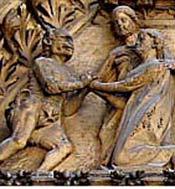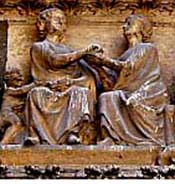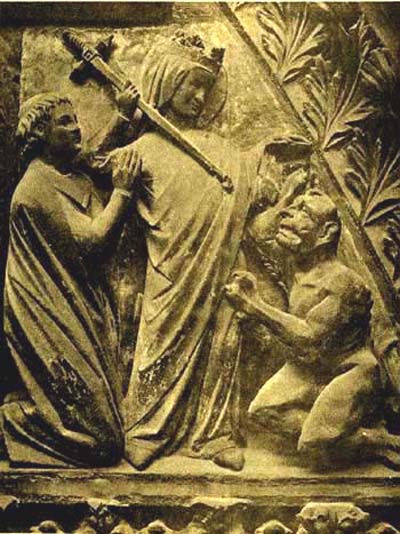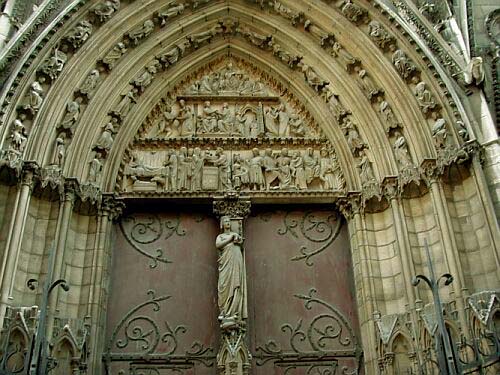
Above, he sells his soul to the Devil
Below, the Bishop reinstates him


Above, he prays to the Virgin
Below, she retrieves the contract
 |
Theophilus was a man who sold his soul to the Devil. It seems that he was not the first, and certainly not the last, one to do such a thing. He signed a contract with the Devil in his own blood to maintain his position in a diocese of Sicily [full story below]. Then after many years, Theophilus became fearful thinking about his death. Touched by grace, he repented and asked Our Lady to rescue him from his pact.
Despite the horrible sin he had committed, Our Lady appeared to him and promised to intercede for him with God. She stood before the Devil threatening him with a sword, took the contract from his hands, and liberated the clerk. This apparition became famous and was immortalized in a stone sculpture on a transept portal of Notre Dame Cathedral.
The principal theme of the story is very beautiful, the same idea that
medieval accounts never fail to stress: The unlimited mercy of Our Lady. She listens to the least request and responds to the smallest manifestation of filial piety, doing extraordinary things.
Incidents like this were repeated before the admiring eyes of all Christendom for centuries in order to firmly establish in our minds that even in the worst and most miserable situation, we will always find help and a solution if we pray to Our Lady. Because of who she is, we can turn to her for a resolution for even the most desperate of situations.
St. Bernard strongly affirms this truth in the Memorare:
“Remember, O most gracious Virgin Mary, that never was it known that anyone who fled to thy protection, implored thy help, or sought thy intercession, was left unaided.”
The story of Theophilus is an illustration of the Memorare. It is proof that Our Lady listens even to the most miserable man in a situation of near despair.
In this episode, we also see another aspect of the sacral personality of Our Lady, which is her holy hatred. She advances toward the Devil with hatred for him. She is the one who smashes the head of the Serpent through the centuries. She hates the Devil, sin, and evil. It is her holy intransigence.
In virginity there is intransigence. In intransigence there is virginity. Virginity never tolerates impurity; and intransigence is a special form of virginity against liberalism. The intransigent person is the one who refuses any concessions to liberalism, that is, concessions to the Revolution. So, between virginity and intransigence, there are profound and mysterious harmonies. Our Lady is a virgin because she is intransigent, and she is intransigent because she is virgin. This harmony exists to perfection in Our Lady.
The sculptor who reproduced the story of the Theophilus had great talent, because the scenes are truly expressive. Let us analyze only the decisive one in which Our Lady forces the return of the document that delivers the soul of Theophilus to the Devil.

Our Lady fighting the Devil |
The Devil is well represented as a ghastly creature. His hand has only three short stubby fingers with sharp, malefic claws. The fingers look like they were amputated and three claws emerged from the stump. He doesn’t seem to have a wrist. The wrist makes a smooth transition between the arm and the hand, giving the hand mobility. In this sculpture, the Devil has no wrist; his first joint movement appears to be the elbow. The picture doesn’t allow me to say for sure, but from the other sculptures we can see that his lower legs end in clawed feet. It is monstrous.
His torso is grotesque with protruding ribs that run along his back forming thick folds. The skin on his body looks like the hide of a rhinoceros. His mouth is enormous, open in an expression of both sarcasm and despair. The gaze, the position of the head and the pose of the body, half-kneeling, share the same spirit: a mixture of cowardice, adulation and mockery. Nothing is praiseworthy in his attitude, everything is horrendous. The ears are disproportionate to the face, the eyes small with the deep furrow that begins at the outer corner. One would say that filthy tears of despair flow eternally from the Devil’s eyes in that furrow. He has a ridiculous topknot as well.
We see that the hand of Our Lady holds the document of the pact, that she ordered the Devil to hand over to her. That monstrous, burly creature had to obey her because he is entirely subordinate to her empire. Even though she is a delicate virgin, she has complete dominion over him.
The attitude of Our Lady toward the Devil can be seen principally in the movement of her upper chest. For instance the two closed fingers on her left hand give an impression of her disgust for him; the way she closes her right hand around the sword shows her decision to punish him. Her physiognomy is severe – a rare thing in statues of Our Lady. She holds the sword above the Devil with the clear intention to kill him were he mortal. It is the sword of intransigence, the sword of maternal protection against the monster who led her son astray. She advances towards the Devil and forces his retreat; he is impotent before her.
While Our Lady’s face is stern toward the Devil, Theophilus is serene. He is fearful, but trusting. He is dressed as a monk in a ripped habit that may have come from the wear of time in the stone, or from the claws of the Devil trying to hold him. It is Our Lady who relieved the fears of Theophilus. She is the one who brings peace of soul. Tonsured like a monk, Theophilus is in a position of prayer, and Our Lady is between him and the Devil, defending him.
On her head Our Lady has a crown to indicate that she is the Queen, the highest dignitary of Heaven. She also has a halo of sanctity to express that she is the Most Holy Mother of God.
This sculpture has an extraordinary life and dynamism. It is very different from the classic sculptures where we see strikingly fine-looking persons with the pretentious airs of contestants in a beauty pageant. The medieval sculpture is alive, real, presenting the noblest human sentiments – maternal love, desire for Heaven, fear of Hell – and the worst, the selling of one’s souls to the Devil for advantages. Even the Devil is presented in a form similar to a human being to make the scene more accessible to the viewer. It is a good example of the vibrant, vigorous life of the Middle Ages.
The sculpture provides us an element for meditation and prayer.
It is a perfect sculpture.

The story of Theophilus is sculpted on the portal of the north transept
in Notre Dame Cathedral, over the statue of Our Lady
|
The Miracle of Theophilus
From The Golden Legend by Jacobus de Voragine
In Sicily in the year 537, as we have from the account by Fulbert of Chartres, there was a man named Theophilus, who served a Bishop as his administrator. Theophilus managed the Church’s affairs so ably that when the Bishop died, the whole populace acclaimed him as worthy of the episcopate. He was content to remain as administrator, however, and preferred to have someone else ordained as Bishop.
But in time, this new Bishop deprived Theophilus, all unwilling, of his office. Theophilus fell into such despair that, in order to regain his honorable post, he sought the advice of a Jewish sorcerer.
The sorcerer summoned the Devil, who came immediately. Thereupon, Theophilus, at the demon’s command, renounced Christ and His Mother, repudiated the Catholic Faith, wrote a statement of his renunciation and repudiation in his own blood, and signed and sealed the script. He then gave it to the Devil, thus pledging himself to his service. The next day, by the Devil’s manipulation, Theophilus was taken back into the Bishop’s good graces and reinstated in his dignities of office.
In time, however, the miserable man came to his senses and regretted what he had done. With all the devotion of his heart, he had recourse to the glorious Virgin. At a certain moment Blessed Mary appeared to him, upbraided him sternly for his impiety, ordered him to renounce the Devil, and made him confess his faith in her and in Christ, the Son of God, and in the whole Catholic doctrine.
So she brought him back into her favor and her Son’s. In token of the forgiveness granted him, she appeared to him again and returned the scroll he had given to the Devil, placing it on his breast as a sign that he need not fear he might be in the demon’s service, and that, through her intervention, he was a free man.
Having received this gift, Theophilus was filled with joy. He went before the Bishop and the whole populace, and gave a full account of the above events. All were filled with admiration and gave praise to the glorious Virgin, and Theophilus, three days later, fell asleep in the peace of the Lord.

Posted on December 7, 2006


Related Topics of Interest
 'Thief! Thief!' 'Thief! Thief!'
 The Miracle of the Aves as Roses The Miracle of the Aves as Roses
 Thy Will be Done ... Thy Will be Done ...
 Refuting Lies about the Middle Ages Refuting Lies about the Middle Ages
 “Be sober and Watch”: Vigilance in Symbols “Be sober and Watch”: Vigilance in Symbols
 The Personality of Charlemagne The Personality of Charlemagne
 Symbolism of the Snow Symbolism of the Snow

|